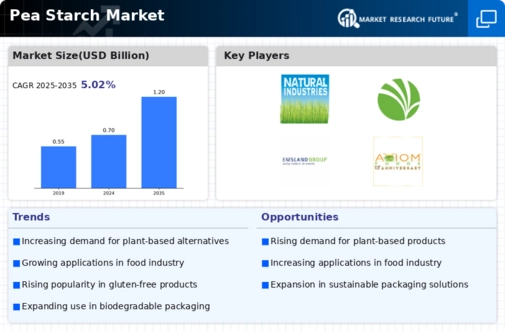Market Trends
Key Emerging Trends in the Pea Starch Market
The pea starch market is experiencing notable trends that reflect the evolving landscape of consumer preferences and industry dynamics. One prominent trend in this market is the increasing demand for plant-based and clean-label products. As more consumers embrace plant-based diets and seek healthier alternatives, pea starch has emerged as a versatile ingredient. Derived from yellow peas, pea starch offers functional properties such as thickening and gelling, making it a popular choice for food manufacturers looking to enhance the nutritional profile of their products without compromising on texture or taste. Health-conscious consumers are driving the demand for pea starch, as it is gluten-free, non-GMO, and hypoallergenic. This aligns with the broader trend of clean eating, where individuals prioritize natural and minimally processed ingredients. The pea starch market has responded by offering a range of products, including pea starch isolates and concentrates, to cater to diverse applications in the food and beverage industry. Moreover, sustainability is a key driver in the pea starch market. Peas are nitrogen-fixing crops that enrich the soil, requiring less synthetic fertilizers compared to other crops. This inherent sustainability aspect has contributed to the market's appeal, as environmentally conscious consumers seek products with lower environmental footprints. As sustainability continues to be a focal point for consumers and businesses alike, pea starch stands out as an eco-friendly ingredient, further propelling its market growth. Another significant trend in the pea starch market is the expanding application scope. Initially recognized for its use in food products, pea starch has found applications in various industries, including pharmaceuticals, textiles, and paper manufacturing. Its versatility and functional properties, such as binding and film-forming capabilities, make it an attractive ingredient for diverse industrial processes. This trend underscores the adaptability of pea starch and its potential to address the needs of multiple sectors beyond the food and beverage industry. The global rise of plant-based protein consumption is also influencing the pea starch market. As a co-product of pea protein extraction, pea starch benefits from the growing popularity of plant-based protein sources. The demand for plant-based proteins is driven by factors such as health consciousness, ethical considerations, and environmental sustainability. This dual-purpose utilization of peas, where both protein and starch are extracted, contributes to the overall economic viability and sustainability of pea processing. Furthermore, technological advancements play a role in shaping the pea starch market. Ongoing research and development efforts are focused on optimizing extraction processes to improve yield and product quality. Additionally, innovations in ingredient combinations and formulations are leading to the development of pea starch blends that offer enhanced functional properties for specific applications. These technological advancements contribute to the market's competitiveness and its ability to meet the evolving demands of the food and industrial sectors.


















Leave a Comment